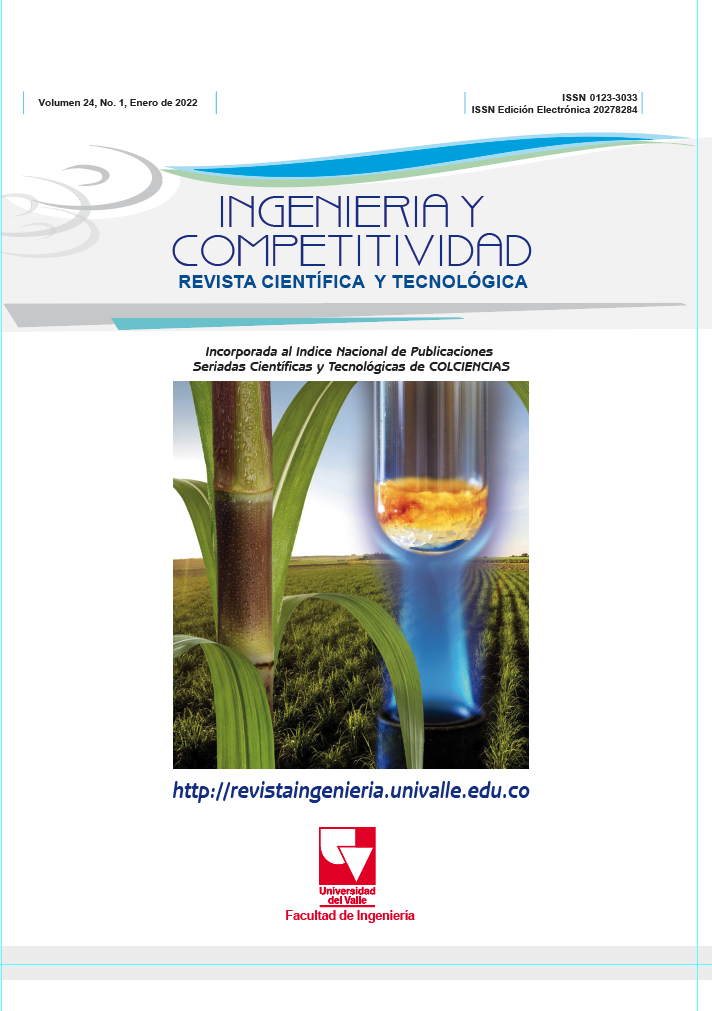Estudio de propiedades mecánicas de un material compuesto de matriz de polipropileno con fibra de guadua y polvo de cerámica
Contenido principal del artículo
El uso de fibras de origen natural como refuerzo en Materiales Compuestos (MC), ha venido tomando fuerza en los últimos años. En este caso se tiene un MC con matriz de polipropileno (PP) reciclado, proveniente de tapas de diferentes envases de productos de consumo diario. Para el refuerzo se eligió usar fibra natural de Guadua angustifolia y polvo de cerámica tenaz. La fibra de Guadua se obtuvo en condiciones de secado e inmunizado con el fin de reducir su humedad y evitar la aparición de hongos y líquenes. El polvo de cerámica tenaz también es un material reciclado, obtenido de pisos de cerámica que se trituraron y pulverizaron previo a la inserción al MC. Las proporciones usadas para fabricar las probetas del MC fueron: una con 100% de PP y otras con diferente composición del MC, donde la matriz de PP se mantuvo con el 60%, y se combinaron los materiales de refuerzo, para obtener los siguientes grupos de especímenes, uno con 30% fibra y 10% cerámica, otro con 33% fibra y 7% cerámica y un último con 35% fibra y 5% cerámica. Una vez obtenidas las probetas del MC, se realizaron los ensayos mecánicos, de tensión según la norma ASTM 638D para polímeros, y de flexión con la norma ASTM 970D para plásticos reforzados. Se analizaron los resultados obtenidos, mediante análisis de varianza (ANOVA), usando un nivel de significancia de α = 0.05 y un enfoque de valor P para la verificación de la hipótesis nula. El análisis estadístico se realizó mediante el software Minitab 18, encontrando como resultado más importante, que el módulo de elasticidad a tensión del PP aumentó en un 53,49%, al adicionarle Guadua en un 35% y cerámica en un 5%.
- Fibras celulósicas
- Materiales alternativos
- Plásticos
- Reciclaje
(1) Daniel IM, Ishai O. Engineering mechanics of composite materials Volumen 13. 2nd ed. New York: Oxford University Press; 2006. 411 p.
(2) Newell J. Ciencia de materiales - aplicaciones en ingeniería. 1a ed. Alfaomega Grupo Editor; 2011. 368 p.
(3) Gil Barroso JR, Camacho AM. Introducción al conocimiento de los materiales y a sus aplicaciones. Editorial UNED; 2010. 718 p.
(4) Ahlgren WL. The Dual-Fuel Strategy: An Energy Transition Plan. Proc IEEE. 2012;100(11):3001–52. https://doi.org/10.1109/JPROC.2012.2192469.
(5) Bolden J, Abu-lebdeh T, Fini E. Utilization of recycled and waste materials in various construction applications. 2013;9(1):14-24. https://doi.org/10.3844/ajessp.2013.14.24.
(6) Alves-Fidelis ME, Castro-Pereira TV, Martins-Gomes O, De Andrade F, Toledo-Filho RD. The effect of fiber morphology on the tensile strength of natural fibers. Journal of Materials Research and Technology. 2013;2(2):149-157. https://doi.org/10.1016/j.jmrt.2013.02.003.
(7) Hurtado SGG, Revelo JC, Pruna CF, Barragán VHG. Obtención y Caracterización de Compuestos de Polipropileno Reforzado con Nanoarcillas Mediante Extrusión e Inyección. Rev Politécnica. 2015;35(3):43. Available from: https://revistapolitecnica.epn.edu.ec/ojs2/index.php/revista_politecnica2/article/view/397.
(8) Caicedo C, Vásquez Arce A, Crespo LM, De la Cruz H, Ossa ÓH. Material compuesto de matriz polipropileno (PP) y fibra de cedro: influencia del compatibilizante PP-g-MA. Inf Téc. 2015;79(2):118. https://doi.org/10.23850/22565035.156.
(9) Passatore CR, Leão AL, Rosa D dos S. Compuestos de polipropileno reforzado con fibra de piasava. In: XIV SLAP/XII CIP 2014. Porto de Galinhas, Brasil: Associação Brasileira de Polímeros - ABPol; 2014.
(10) Silva GD, Almeida YM, Sanguinetti RAF, Yadava YP. efeitos da adição de partículas de alumina em compósitos de polipropileno. In: 12° Congresso Brasileiro de Polímeros (12°CBPol) [Internet]. São Carlos: Associação Brasileira de Polímeros - ABPol; 2013. p. 1–4. Available from: http://e-democracia.com.br/cbpol/anais/2013/pdf/6FCN.pdf
(11) Ordoñez-Benavides GJ. Evaluación de las propiedades térmicas y mecánicas del polipropileno reforzado con zeolitas tipo ZSM-5. [Master’s Thesis]. Medellín: Instituto Tecnológico Metropolitano; 2016. Available from: https://repositorio.itm.edu.co/handle/20.500.12622/502
(12) Rosales C, Sabino M, Perera R, Rojas H, Romero N. Estudio de mezclas de poli (ácido láctico) con polipropileno y nanocompuestos con montmorillonita. Rev Latinoam Metal Mater. 2014;34(1):158-71.
(13) Pilaguano-Guanochanga JG, Vizueta-Caisatoa PJ. Caracterización de compuestos de polipropileno reforzados con polvo de Bambú y nanoarcillas obtenidos mediante extrusión e inyección [Bacherlor’s Thesis]. Quito: Escuela Politécnica Nacional; 2017. Available from: http://bibdigital.epn.edu.ec/handle/15000/17383
(14) Jaramillo N, Hoyos D, Santa JF. Compuesto de fibra de hoja de piña fabricados mediante moldeo por compresion por capas. Ing Compet. 2016;18(2):151-62. https://doi.org/10.25100/iyc.v18i2.2163
(15) McDonald GR, Hudson AL, Dunn SMJ, You H, Baker GB, Whittal RM, et al. Bioactive contaminants leach from disposable laboratory plasticware. Science. 2008;322(5903):917. https://doi.org/10.1126/science.1162395
(16) Greenpeace. ¿Cómo llega el plástico a los océanos y qué sucede entonces? - ES [Internet]. Greenpeace España. 2015 [citado mayo 25 de 2020]. Available from: https://es.greenpeace.org/es/trabajamos-en/consumismo/plasticos/como-llega-el-plastico-a-los-oceanos-y-que-sucede-entonces/
(17) Minke G. Manual de construcción con Bambú. 1a ed. Cali, Colombia: Merlin S.E. SAS; 2010. 154 p.
(18) Malagón E. Materiales cerámicos: propiedades, aplicaciones y elaboración. UNAM; 2005. 168 p
(19) PQI de Occidente. Polipropileno [Internet]. 2013 [cited 2020 may 25]. Disponible en: http://www.plasquim.net/polipropileno.html
(20) López LF, Correal JF. Estudio exploratorio de los laminados de bambú Guadua angustifolia como material estructural. Maderas Cienc Tecnol. 2009;11(3):171-82. http://dx.doi.org/10.4067/S0718-221X2009000300001
(21) ASTM D-638 Standard Test Method for Flexural Properties Of Unreinforced And Reinforced Plastics And Electrical nsulating Materials. West Conshohocken: ASTM International.; 2001.
(22) ASTM D-790 Standard Test Method for Tensile Properties of Polymer Matrix Composite Materials. West Conshohocken: ASTM International; 2010.
(23) Douglas C. Montgomery. Diseño y análisis de experimentos. segunda. Mexico: Limusa, S.A. de C.V.; 2004. 692 p.
Descargas

Esta obra está bajo una licencia internacional Creative Commons Atribución-NoComercial-CompartirIgual 4.0.
Los autores que publican en esta revista están de acuerdo con los siguientes términos:
Los autores ceden los derechos patrimoniales a la revista y a la Universidad del Valle sobre los manuscritos aceptados, pero podrán hacer los reusos que consideren pertinentes por motivos profesionales, educativos, académicos o científicos, de acuerdo con los términos de la licencia que otorga la revista a todos sus artículos.
Los artículos serán publicados bajo la licencia Creative Commons 4.0 BY-NC-SA (de atribución, no comercial, sin obras derivadas).





